Study on the Basic Form of Reservoir Operation Rule Curves for Water Supply and Power Generation
Abstract
:1. Introduction
2. Materials and Methods
2.1. Study Site
2.2. Parameter–Simulation–Optimization Framework
- ①
- Generate a set of initial operation rules within the feasible range.
- ②
- Simulate the reservoir’s operation process based on these operation rules and calculate relevant evaluation indicators.
- ③
- Convert these indicators into fitness values that can be used by the intelligent optimization method.
- ④
- Evaluate all operation rules and generate new operation rules through the intelligent optimization method.
- ⑤
- Check if the stopping criterion is met. If it is met, the iteration process stops. Otherwise, go back to step ②.
2.3. Reservoir Operation Rules
2.3.1. Independent Operation Rule Curves
- (1)
- Water supply rules
- (2)
- Hydropower generation rules
- (3)
- Final outflow rules
2.3.2. Shared Operation Rule Curves
- (1)
- Water supply rules
- (2)
- Hydropower generation rules
- (3)
- Final outflow rules
2.4. Reservoir Operation Model
- (1)
- Objective function
- (2)
- Constraint condition
- ①
- Water balance constraints
- ②
- Reservoir capacity constraints
- ③
- Maximum overflow capacity constraints
- ④
- Power output constraints
- ⑤
- Reliability constraints
- (3)
- Solution methods
3. Results and Discussion
3.1. Comparison of Water Supply Potential
3.2. Comparison of Pareto Solution Sets for Different Operation Rule Curves in a Multi-Water Use Scenario
- (1)
- Designing different water demand scenarios
- (2)
- Comparison of different operation rule curves solution sets under multiple scenarios
4. Conclusions
- (1)
- The choice of operation rule curves has an impact on the maximum water supply potential of the reservoir. The independent operation rule curves show better potential for industrial, domestic, and environmental water supply compared to the shared operation rule curves. The maximum water supply for industrial and domestic purposes can be increased by 3.5 × 108 m3, an improvement of 10.8%. The maximum water supply for environmental purposes can be increased by 1 × 108 m3, an improvement of 3.4%.
- (2)
- In cases where water demand is relatively low, the shared operation rule curves can achieve similar functionality to the independent operation rule curves and yield better solution sets. By utilizing the shared operation rule curves, the number of optimization variables can be reduced by nearly half. For complex reservoir systems, analyzing the basic form of the operation rule curves can help identify common patterns among reservoirs, thus minimizing the number of optimization variables, enhancing the efficiency of the optimization process, and improving the structure of the optimization model.
- (3)
- When water demand is relatively high, the solution sets obtained using the independent operation rule curves are notably superior. Industrial and domestic water usage can be reduced by 20.1 × 106 m3 or by 20%. The independent operation rule curve optimization yielded a total of 6549 non-dominated solutions, which were superior in overall solution quality compared to the solutions obtained through the shared operation rule curve optimization. If the goal is to maximize reservoir operation benefits, the independent operation rule curves can be employed to achieve multi-objective optimization.
Author Contributions
Funding
Data Availability Statement
Conflicts of Interest
References
- Yang, G.; Guo, S.; Liu, P.; Li, L.; Xu, C. Multiobjective reservoir operating rules based on cascade reservoir input variable selection method. Water Resour. Res. 2017, 53, 3446–3463. [Google Scholar] [CrossRef]
- Jeuland, M.; Whittington, D. Water resources planning under climate change: Assessing the robustness of real options for the Blue Nile. Water Resour. Res. 2014, 50, 2086–2107. [Google Scholar] [CrossRef]
- Dabhade, P.D.; Regulwar, D.G. Sustainable Multi-Objective Multi-Reservoir Optimization Considering Environmental Flow. J. Water Resour. Prot. 2021, 13, 945–956. [Google Scholar] [CrossRef]
- Guo, X.; Hu, T.; Lu, Y.; Zhang, T. Multi-reservoir operating rule in inter-basin water transfer-supply project. Shuili Xuebao J. Hydraul. Eng. 2012, 43, 757–766. [Google Scholar]
- Peng, A.; Peng, Y.; Zhou, H.; Zhang, C. Multi-reservoir joint operating rule in inter-basin water transfer-supply project. Sci. China Technol. Sci. 2015, 58, 123–137. [Google Scholar] [CrossRef]
- Giuliani, M.; Galelli, S.; Soncini-Sessa, R. A dimensionality reduction approach for many-objective Markov Decision Processes: Application to a water reservoir operation problem. Environ. Model. Softw. 2014, 57, 101–114. [Google Scholar] [CrossRef]
- Guo, K.; Zhang, L. Multi-objective optimization for improved project management: Current status and future directions. Autom. Constr. 2022, 139, 104256. [Google Scholar] [CrossRef]
- Zhang, C.; Li, Y.; Chu, J.; Fu, G.; Tang, R.; Qi, W. Use of many-objective visual analytics to analyze water supply objective trade-offs with water transfer. J. Water Resour. Plan. Manag. 2017, 143, 05017006. [Google Scholar] [CrossRef]
- Chu, J.; Zhang, C.; Fu, G.; Li, Y.; Zhou, H. Improving multi-objective reservoir operation optimization with sensitivity-informed dimension reduction. Hydrol. Earth Syst. Sci. 2015, 19, 3557–3570. [Google Scholar] [CrossRef]
- Li, F.-F.; Qiu, J. Multi-objective reservoir optimization balancing energy generation and firm power. Energies 2015, 8, 6962–6976. [Google Scholar] [CrossRef]
- Reddy, M.J.; Nagesh Kumar, D. Multi-objective particle swarm optimization for generating optimal trade-offs in reservoir operation. Hydrol. Process. Int. J. 2007, 21, 2897–2909. [Google Scholar] [CrossRef]
- Matrosov, E.S.; Huskova, I.; Kasprzyk, J.R.; Harou, J.J.; Lambert, C.; Reed, P.M. Many-objective optimization and visual analytics reveal key trade-offs for London’s water supply. J. Hydrol. 2015, 531, 1040–1053. [Google Scholar] [CrossRef]
- Mirjalili, S.; Jangir, P.; Mirjalili, S.Z.; Saremi, S.; Trivedi, I.N. Optimization of problems with multiple objectives using the multi-verse optimization algorithm. Knowl. -Based Syst. 2017, 134, 50–71. [Google Scholar] [CrossRef]
- Fang, R.; Popole, Z. Multi-objective optimized scheduling model for hydropower reservoir based on improved particle swarm optimization algorithm. Environ. Sci. Pollut. Res. 2020, 27, 12842–12850. [Google Scholar] [CrossRef] [PubMed]
- Hu, T.; Zhang, X.-Z.; Zeng, X.; Wang, J. A two-step approach for analytical optimal hedging with two triggers. Water 2016, 8, 52. [Google Scholar] [CrossRef]
- Yu, Y.; Zhou, T.; Zhao, R.; Zhang, J.; Min, X. Bi-level hybrid game model for optimal operation of multi-function reservoir considering integrated water resource management. Environ. Sci. Pollut. Res. 2022, 1–18. [Google Scholar] [CrossRef] [PubMed]
- Tang, R.; Ding, W.; Ye, L.; Wang, Y.; Zhou, H. Tradeoff analysis index for many-objective reservoir optimization. Water Resour. Manag. 2019, 33, 4637–4651. [Google Scholar] [CrossRef]
- Smith, R.; Kasprzyk, J.; Zagona, E. Many-objective analysis to optimize pumping and releases in multireservoir water supply network. J. Water Resour. Plan. Manag. 2016, 142, 04015049. [Google Scholar] [CrossRef]
- Chang, L.-C.; Chang, F.-J. Multi-objective evolutionary algorithm for operating parallel reservoir system. J. Hydrol. 2009, 377, 12–20. [Google Scholar] [CrossRef]
- Woodruff, M.J.; Reed, P.M.; Simpson, T.W. Many objective visual analytics: Rethinking the design of complex engineered systems. Struct. Multidiscip. Optim. 2013, 48, 201–219. [Google Scholar] [CrossRef]
- Mansouri, S.; Fathian, H.; Shahbazi, A.N.; Lour, M.A.; Asareh, A. Multi objective simulation–optimization operation of dam reservoir in low water regions based on hedging principles. Environ. Sci. Pollut. Res. 2023, 30, 41581–41590. [Google Scholar] [CrossRef] [PubMed]
- Liu, P.; Guo, S.; Xu, X.; Chen, J. Derivation of aggregation-based joint operating rule curves for cascade hydropower reservoirs. Water Resour. Manag. 2011, 25, 3177–3200. [Google Scholar] [CrossRef]
- Ahmadi Najl, A.; Haghighi, A.; Vali Samani, H.M. Simultaneous optimization of operating rules and rule curves for multireservoir systems using a self-adaptive simulation-GA model. J. Water Resour. Plan. Manag. 2016, 142, 04016041. [Google Scholar] [CrossRef]
- Li, Y.; Ding, W.; Chen, X.; Cai, X.; Zhang, C. An analytical framework for reservoir operation with combined natural inflow and controlled inflow. Water Resour. Res. 2020, 56, e2019WR025347. [Google Scholar] [CrossRef]
- Yang, S.; Yang, D.; Chen, J.; Zhao, B. Real-time reservoir operation using recurrent neural networks and inflow forecast from a distributed hydrological model. J. Hydrol. 2019, 579, 124229. [Google Scholar] [CrossRef]
- Khadr, M.; Schlenkhoff, A. GA-based implicit stochastic optimization and RNN-based simulation for deriving multi-objective reservoir hedging rules. Environ. Sci. Pollut. Res. 2021, 28, 19107–19120. [Google Scholar] [CrossRef] [PubMed]
- Ahmadianfar, I.; Samadi-Koucheksaraee, A.; Razavi, S. Design of optimal operating rule curves for hydropower multi-reservoir systems by an influential optimization method. Renew. Energy 2023, 211, 508–521. [Google Scholar] [CrossRef]
- Moeini, R.; Hadiyan, P.P. Hybrid methods for reservoir operation rule curve determination considering uncertain future condition. Sustain. Comput. Inform. Syst. 2022, 35, 100727. [Google Scholar] [CrossRef]
- El Harraki, W.; Ouazar, D.; Bouziane, A.; Hasnaoui, D. Optimization of reservoir operating curves and hedging rules using genetic algorithm with a new objective function and smoothing constraint: Application to a multipurpose dam in Morocco. Environ. Monit. Assess. 2021, 193, 196. [Google Scholar] [CrossRef]
- SeethaRam, K.V. Three Level Rule Curve for Optimum Operation of a Multipurpose Reservoir using Genetic Algorithms. Water Resour. Manag. 2021, 35, 353–368. [Google Scholar] [CrossRef]
- Kosasaeng, S.; Yamoat, N.; Ashrafi, S.M.; Kangrang, A. Extracting Optimal Operation Rule Curves of Multi-Reservoir System Using Atom Search Optimization, Genetic Programming and Wind Driven Optimization. Sustainability 2022, 14, 16205. [Google Scholar] [CrossRef]
- Takada, A.; Hiramatsu, K.; Trieu, N.A.; Harada, M.; Tabata, T. Development of an optimizing method for the operation rule curves of a multipurpose reservoir in a Southeast Asian watershed. Paddy Water Environ. 2019, 17, 195–202. [Google Scholar] [CrossRef]
- Ngoc, T.A.; Hiramatsu, K.; Harada, M. Optimizing the rule curves of multi-use reservoir operation using a genetic algorithm with a penalty strategy. Paddy Water Environ. 2014, 12, 125–137. [Google Scholar] [CrossRef]
- Ahmadianfar, I.; Samadi-Koucheksaraee, A.; Asadzadeh, M. Extract nonlinear operating rules of multi-reservoir systems using an efficient optimization method. Sci. Rep. 2022, 12, 18880. [Google Scholar] [CrossRef]
- Ahmadianfar, I.; Kheyrandish, A.; Jamei, M.; Gharabaghi, B. Optimizing operating rules for multi-reservoir hydropower generation systems: An adaptive hybrid differential evolution algorithm. Renew. Energy 2021, 167, 774–790. [Google Scholar] [CrossRef]
- Chen, L.; McPhee, J.; Yeh, W.W.G. A diversified multiobjective GA for optimizing reservoir rule curves. Adv. Water Resour. 2007, 30, 1082–1093. [Google Scholar] [CrossRef]
- Tang, R.; Li, K.; Ding, W.; Wang, Y.; Zhou, H.; Fu, G. Reference point based multi-objective optimization of reservoir operation: A comparison of three algorithms. Water Resour. Manag. 2020, 34, 1005–1020. [Google Scholar] [CrossRef]
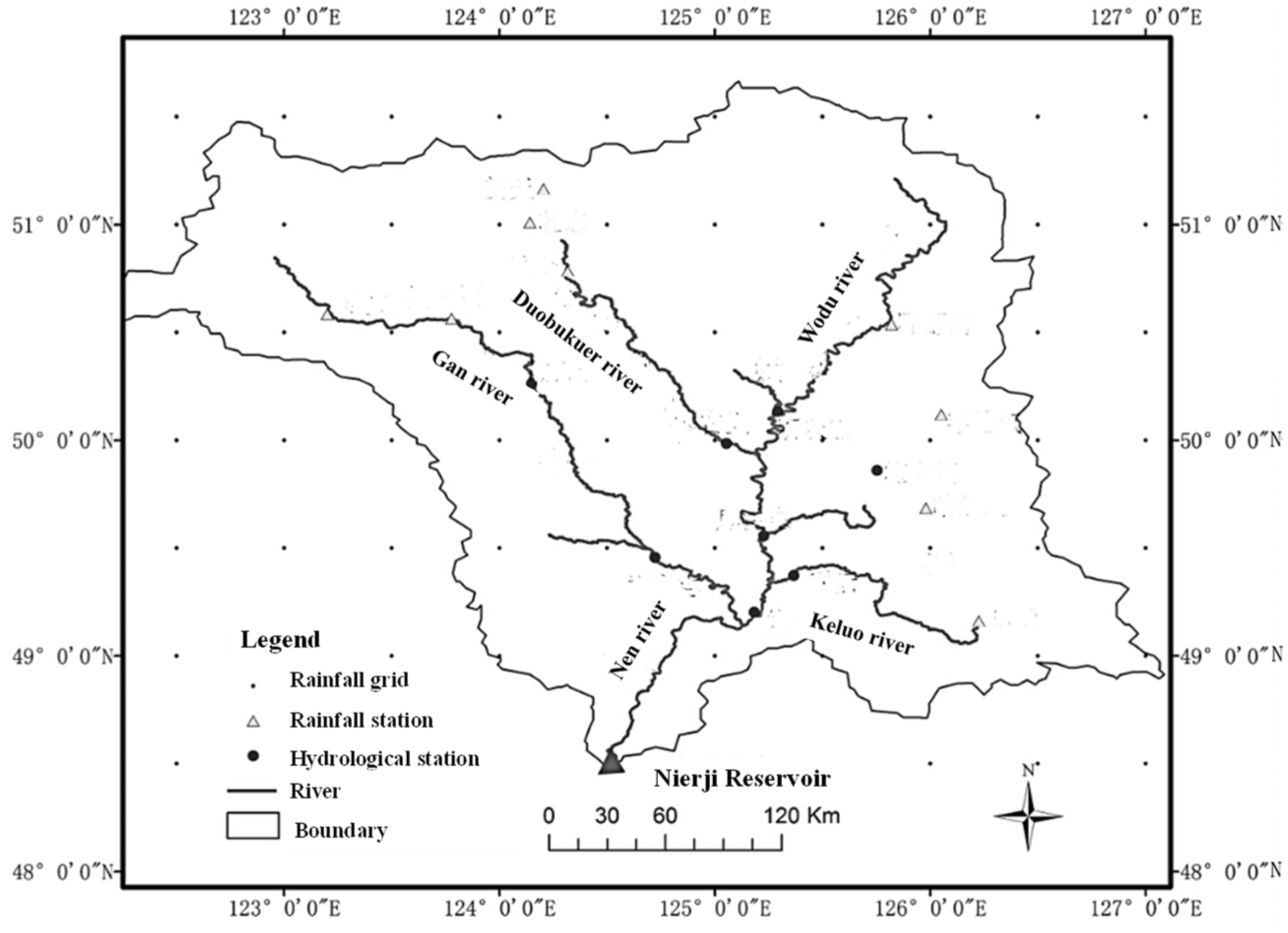
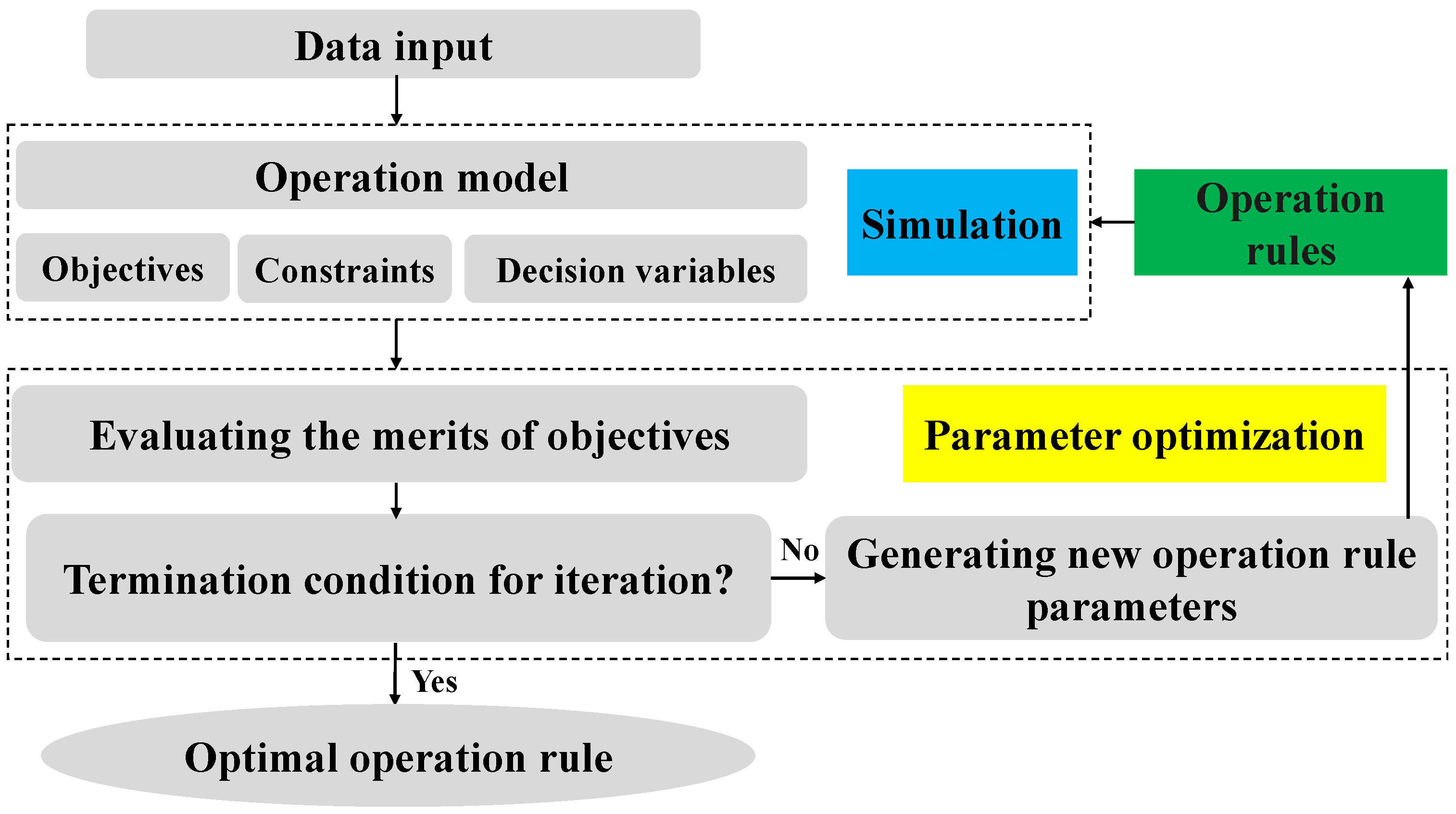
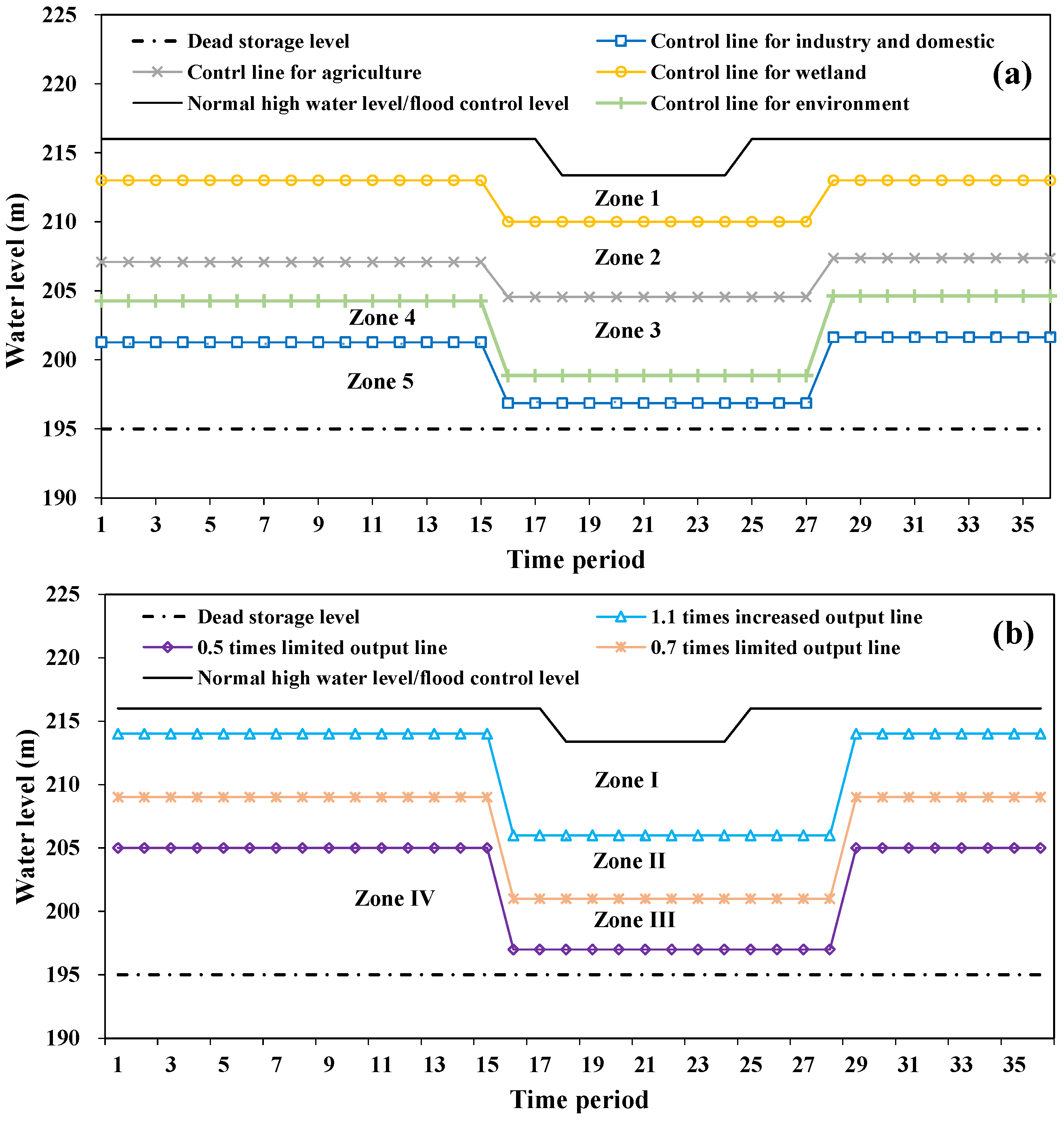

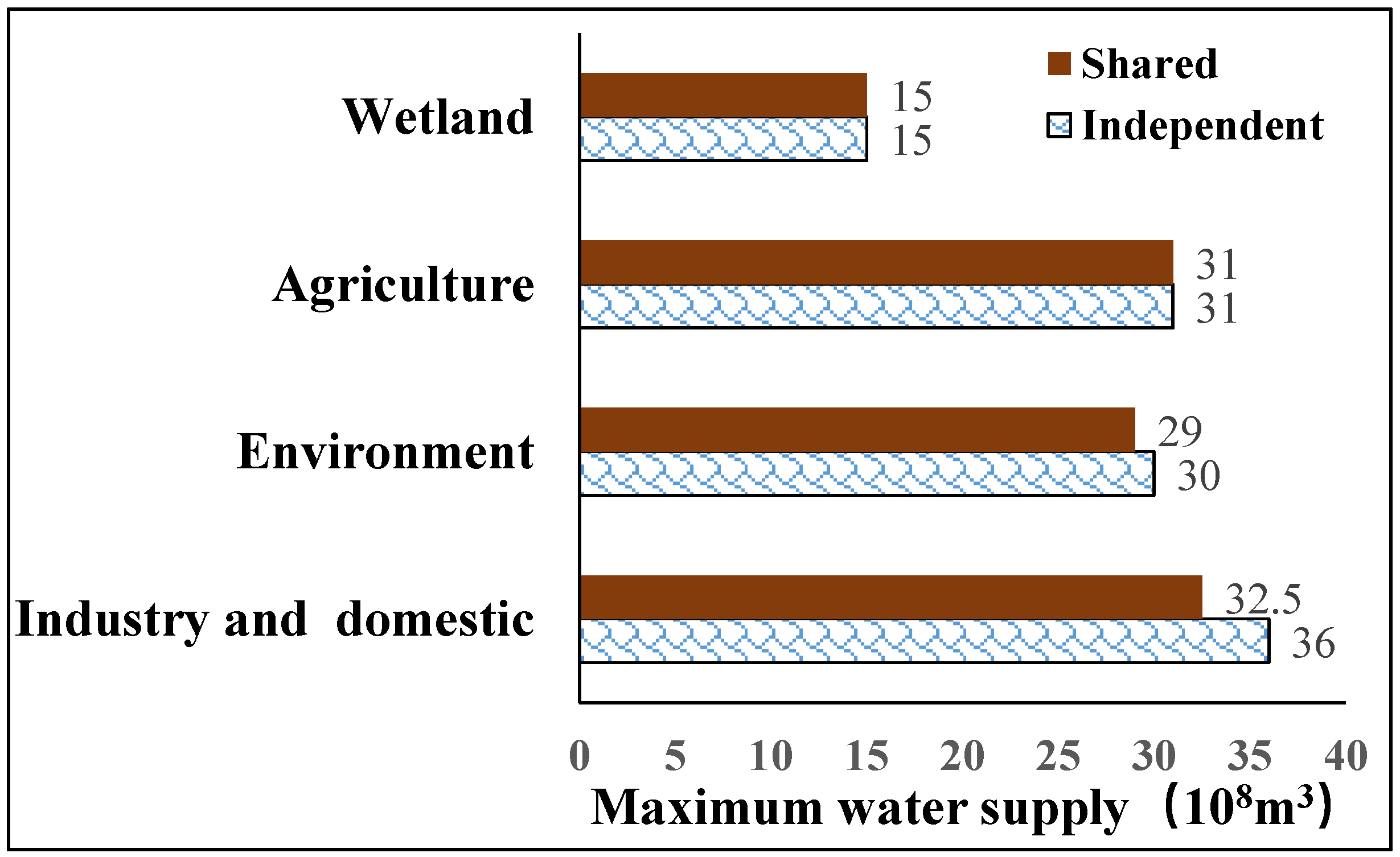
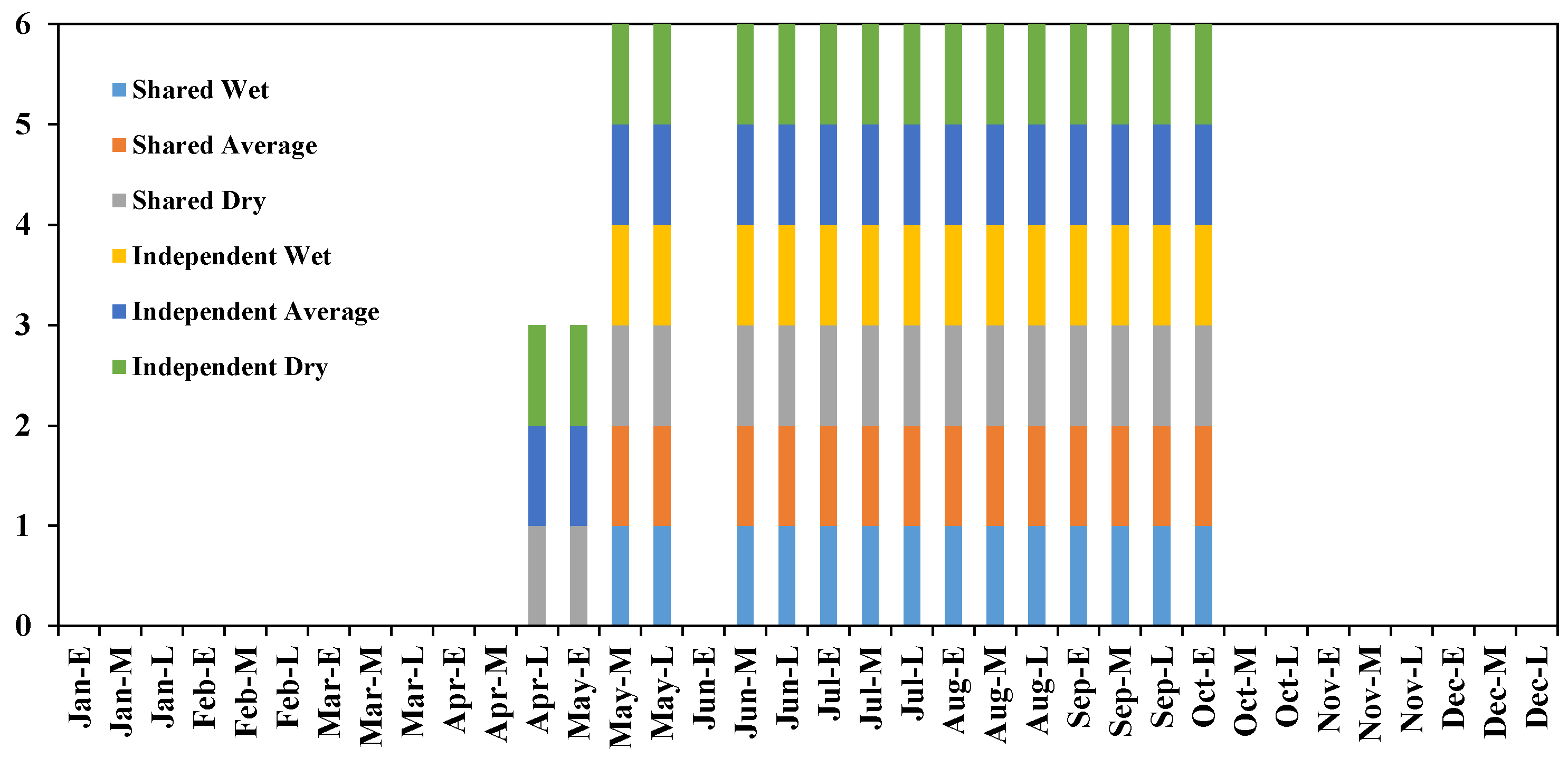
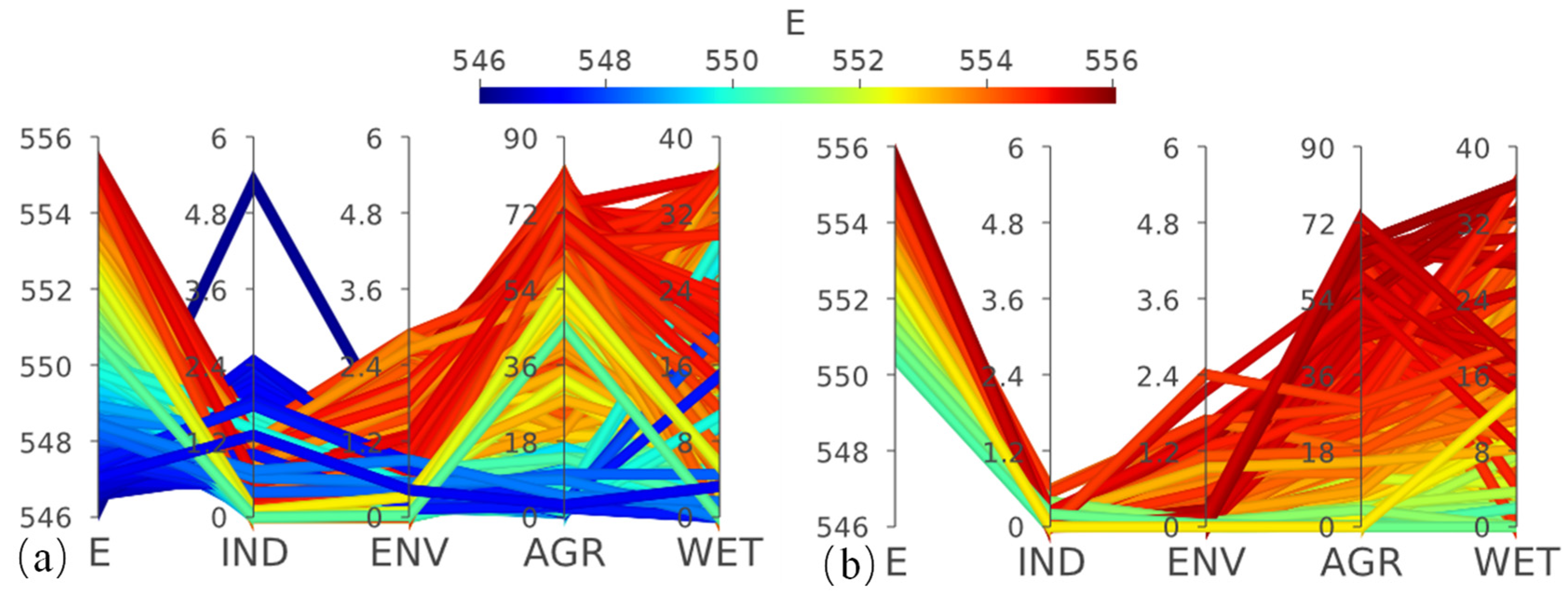
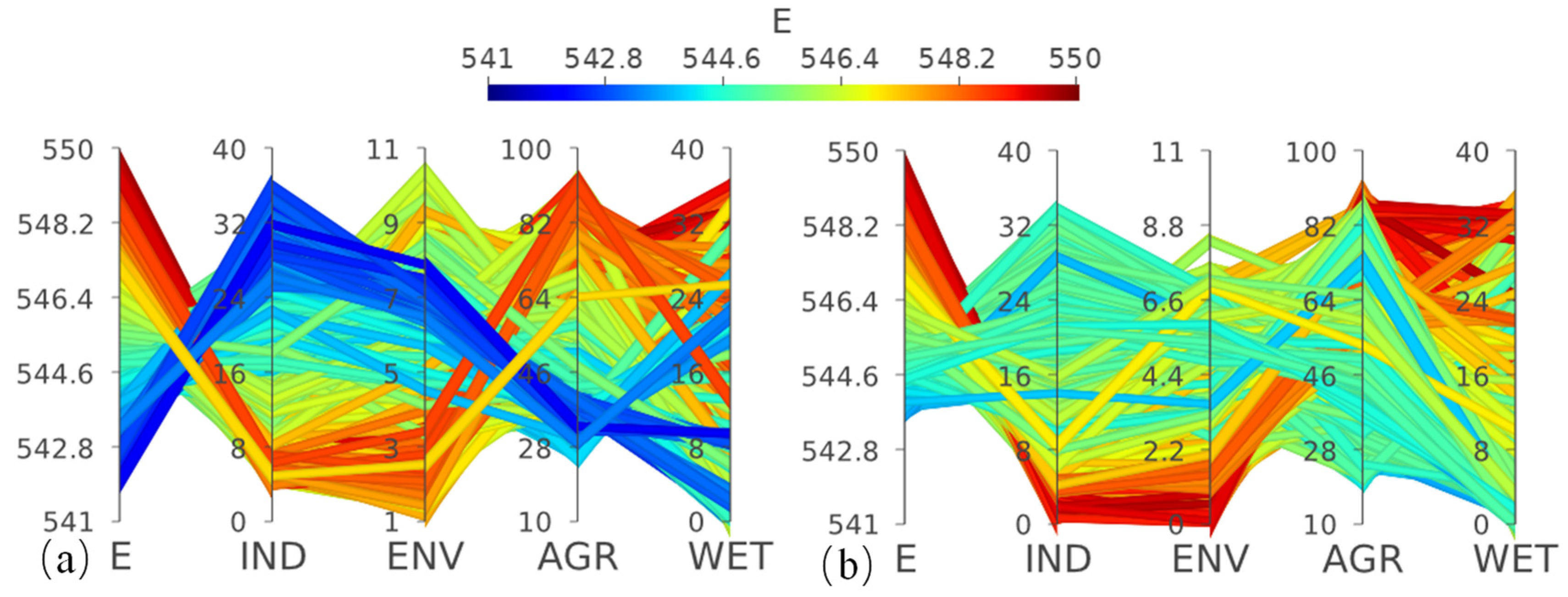
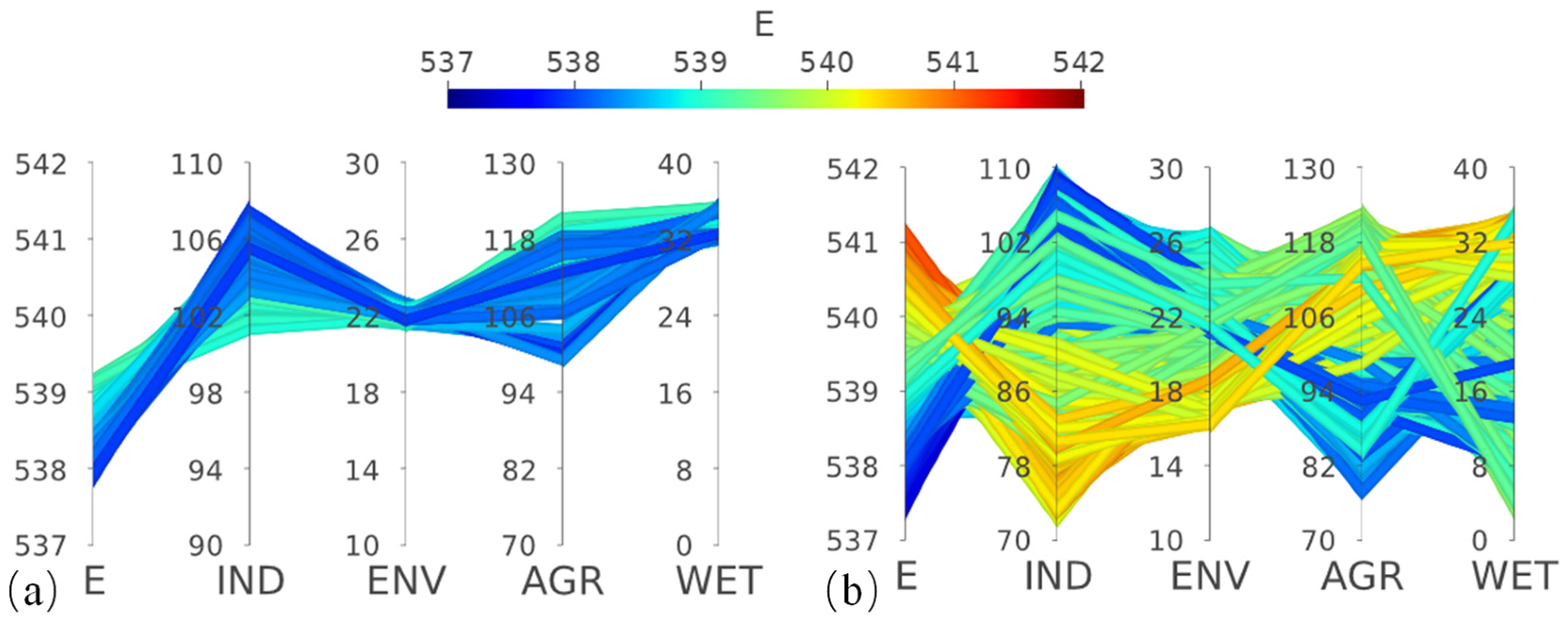
| Scenario | Annual Water Demand (108 m3) | E (MW) | |||
|---|---|---|---|---|---|
| Industry and Domestic | Environment | Agriculture | Wetlands | ||
| S1 (Low) | 10.29 | 13.65 | 16.46 | 3.28 | 35 |
| S2 (Medium) | 20 | ||||
| S3 (High) | 32.5 | ||||
| Scenario | Curve Form | E | IND | ENV | AGR | WET |
|---|---|---|---|---|---|---|
| S1 (D_ind = 10.29) | Shared | 555.34 | 0.00 | 0.00 | 0.90 | 0.00 |
| Independent | 555.70 | 0.00 | 0.00 | 0.00 | 0.00 | |
| S2 (D_ind = 20) | Shared | 549.64 | 3.84 | 1.15 | 25.00 | 0.00 |
| Independent | 549.57 | 0.48 | 0.04 | 19.92 | 0.00 | |
| S3 (D_ind = 32.5) | Shared | 539.17 | 92.48 | 21.48 | 99.00 | 31.84 |
| Independent | 541.13 | 72.38 | 16.16 | 77.83 | 3.48 |
| Scenario | Curve Form | No. of Non-Dominated Solutions |
|---|---|---|
| S1 (D_ind = 10.29) | Shared | 24 |
| Independent | 574 | |
| S2 (D_ind = 20) | Shared | 1131 |
| Independent | 3258 | |
| S3 (D_ind = 32.5) | Shared | 0 |
| Independent | 6549 |
Disclaimer/Publisher’s Note: The statements, opinions and data contained in all publications are solely those of the individual author(s) and contributor(s) and not of MDPI and/or the editor(s). MDPI and/or the editor(s) disclaim responsibility for any injury to people or property resulting from any ideas, methods, instructions or products referred to in the content. |
© 2024 by the authors. Licensee MDPI, Basel, Switzerland. This article is an open access article distributed under the terms and conditions of the Creative Commons Attribution (CC BY) license (https://creativecommons.org/licenses/by/4.0/).
Share and Cite
Tang, R.; Zhang, J.; Wang, Y.; Zhang, X. Study on the Basic Form of Reservoir Operation Rule Curves for Water Supply and Power Generation. Water 2024, 16, 276. https://doi.org/10.3390/w16020276
Tang R, Zhang J, Wang Y, Zhang X. Study on the Basic Form of Reservoir Operation Rule Curves for Water Supply and Power Generation. Water. 2024; 16(2):276. https://doi.org/10.3390/w16020276
Chicago/Turabian StyleTang, Rong, Jiabin Zhang, Yuntao Wang, and Xiaoli Zhang. 2024. "Study on the Basic Form of Reservoir Operation Rule Curves for Water Supply and Power Generation" Water 16, no. 2: 276. https://doi.org/10.3390/w16020276
APA StyleTang, R., Zhang, J., Wang, Y., & Zhang, X. (2024). Study on the Basic Form of Reservoir Operation Rule Curves for Water Supply and Power Generation. Water, 16(2), 276. https://doi.org/10.3390/w16020276






